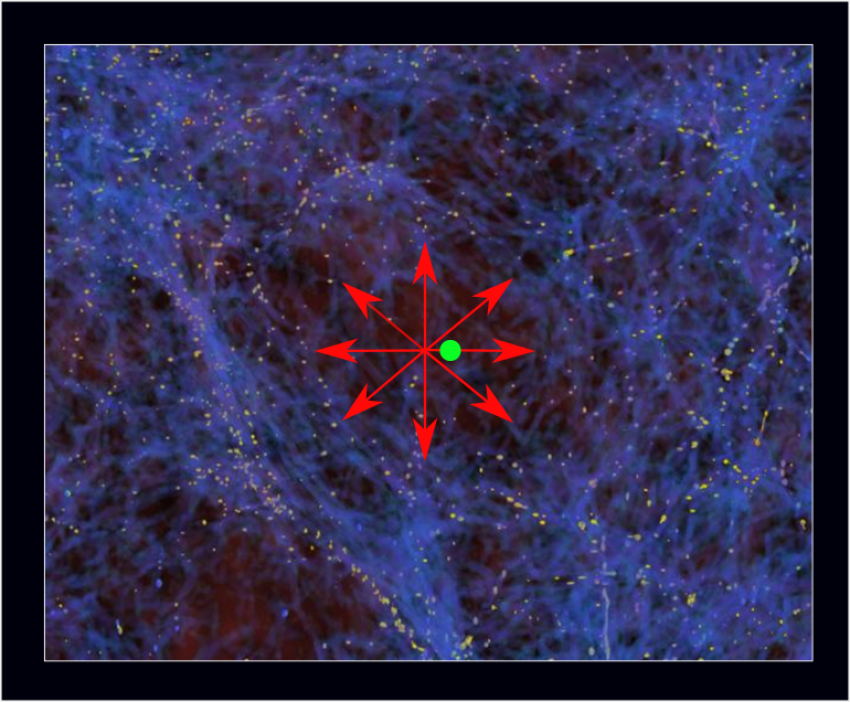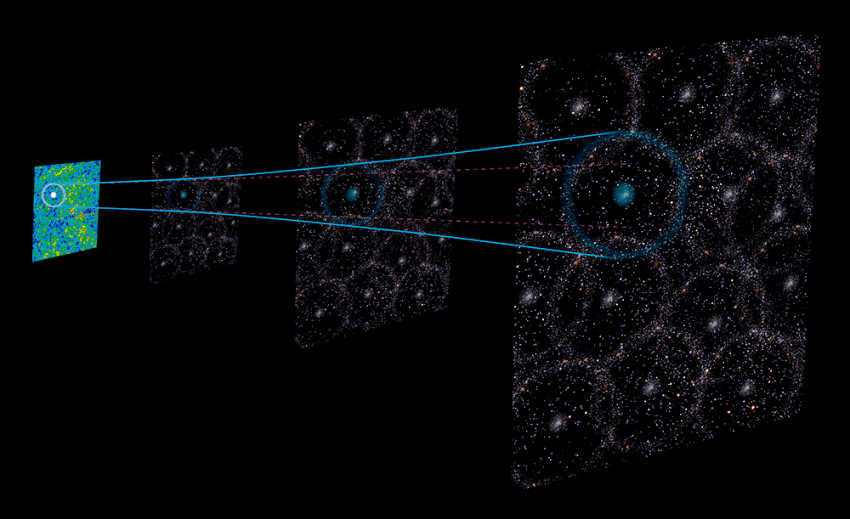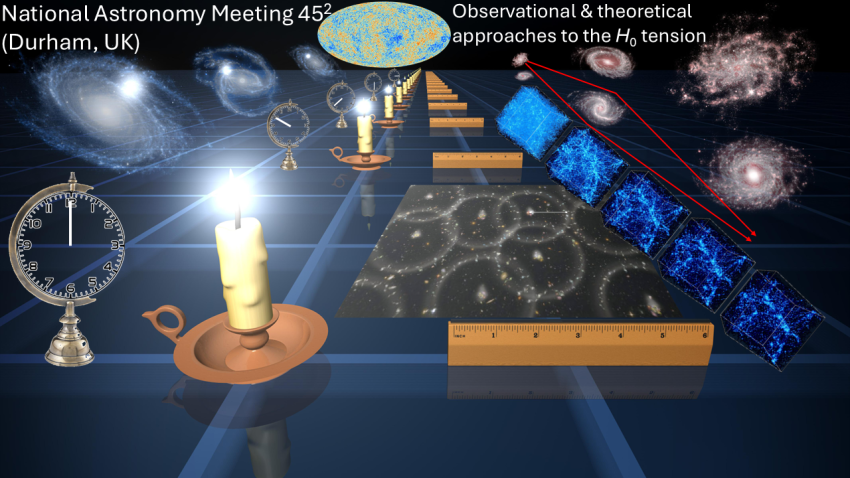Earth and our entire Milky Way galaxy may sit inside a mysterious giant hole which makes the cosmos expand faster here than in neighbouring regions of the universe, astronomers say.
Their theory is a potential solution to the 'Hubble tension' and could help confirm the true age of our universe, which is estimated to be around 13.8 billion years old.
The latest research – shared at the Royal Astronomical Society’s National Astronomy Meeting (NAM) in Durham – shows that sound waves from the early universe, "essentially the sound of the Big Bang", support this idea.
The Hubble constant was first proposed by Edwin Hubble in 1929 to express the rate of the universe's expansion. It can be measured by observing the distance of celestial objects and how fast they are moving away from us.
The stumbling block, however, is that extrapolating measurements of the distant, early universe to today using the standard cosmological model predicts a slower rate of expansion than measurements of the nearby, more recent universe. This is the Hubble tension.
"A potential solution to this inconsistency is that our galaxy is close to the centre of a large, local void," explained Dr Indranil Banik, of the University of Portsmouth.
"It would cause matter to be pulled by gravity towards the higher density exterior of the void, leading to the void becoming emptier with time.
"As the void is emptying out, the velocity of objects away from us would be larger than if the void were not there. This therefore gives the appearance of a faster local expansion rate."
He added: "The Hubble tension is largely a local phenomenon, with little evidence that the expansion rate disagrees with expectations in the standard cosmology further back in time.
"So a local solution like a local void is a promising way to go about solving the problem."
For the idea to stand up, Earth and our solar system would need to be near the centre of a void about a billion light-years in radius and with a density about 20 per cent below the average for the universe as a whole.
Directly counting galaxies does support the theory, because the number density in our local universe is lower than in neighbouring regions.
However, the existence of such a large and deep void is controversial because it doesn't mesh particularly well with the standard model of cosmology, which suggests matter today should be more uniformly spread out on such large scales.
Despite this, new data presented by Dr Banik at NAM 2025 shows that baryon acoustic oscillations (BAOs) – the "sound of the Big Bang" – support the idea of a local void.
"These sound waves travelled for only a short while before becoming frozen in place once the universe cooled enough for neutral atoms to form," he explained.
"They act as a standard ruler, whose angular size we can use to chart the cosmic expansion history.
"A local void slightly distorts the relation between the BAO angular scale and the redshift, because the velocities induced by a local void and its gravitational effect slightly increase the redshift on top of that due to cosmic expansion.
"By considering all available BAO measurements over the last 20 years, we showed that a void model is about one hundred million times more likely than a void-free model with parameters designed to fit the CMB observations taken by the Planck satellite, the so-called homogeneous Planck cosmology."
The next step for researchers is to compare their local void model with other methods to estimate the history of the universe’s expansion, such as cosmic chronometers.
This involves looking at galaxies that are no longer forming stars. By observing their spectra, or light, it is possible to find what kinds of stars they have and in what proportion. Since more massive stars have shorter lives, they are absent in older galaxies, providing a way to establish a galaxy’s age.
Astronomers can then combine this age with the galaxy’s redshift – how much the wavelength of its light has been stretched – which tells us how much the universe has expanded while light from the galaxy was travelling towards us. This sheds light on the universe's expansion history.
ENDS
Media contacts
Sam Tonkin
Royal Astronomical Society
Mob: +44 (0)7802 877 700
Dr Robert Massey
Royal Astronomical Society
Mob: +44 (0)7802 877 699
Megan Eaves
Royal Astronomical Society
Science contacts
Dr Indranil Banik
University of Portsmouth
Images & captions
Caption: If we are located in a region with below-average density such as the green dot, then matter would flow away from us due to stronger gravity from the surrounding denser regions, as shown by the red arrows.
Credit: Moritz Haslbauer and Zarija Lukic
Caption: Baryon acoustic oscillations (BAOs) – the "sound of the Big Bang" – support the idea of a local void.
Credit: Gabriela Secara, Perimeter Institute
Caption: The main techniques for charting the cosmic expansion history, such as supernovae – or standard candles – and cosmic chronometers.
Credit: Dr Indranil Banik
Further information
The talk 'Theoretical and observational approaches to the Hubble tension' will take place at NAM at 14:15 BST on Wednesday 9 July 2025 in room OCW017. Find out more at: https://conference.astro.dur.ac.uk/event/7/sessions/90/#20250709
The Hubble constant was first proposed by Edwin Hubble in 1929 to express the rate of the universe’s expansion. It can be measured by observing the distance of celestial objects and how fast they are moving away from us.
The Hubble tension refers to the discrepancy in the measured expansion rate of the universe, specifically between the value based on observations of the early universe and value related to observations of the local universe.
Baryon acoustic oscillations are a pattern of wrinkles in the density distribution of the clusters of galaxies spread across the universe. They provide an independent way to measure the expansion rate of the universe and how that rate has changed throughout cosmic history.
Notes for editors
The NAM 2025 conference is principally sponsored by the Royal Astronomical Society and Durham University.
About the Royal Astronomical Society
The Royal Astronomical Society (RAS), founded in 1820, encourages and promotes the study of astronomy, solar-system science, geophysics and closely related branches of science.
The RAS organises scientific meetings, publishes international research and review journals, recognises outstanding achievements by the award of medals and prizes, maintains an extensive library, supports education through grants and outreach activities and represents UK astronomy nationally and internationally. Its more than 4,000 members (Fellows), a third based overseas, include scientific researchers in universities, observatories and laboratories as well as historians of astronomy and others.
The RAS accepts papers for its journals based on the principle of peer review, in which fellow experts on the editorial boards accept the paper as worth considering. The Society issues press releases based on a similar principle, but the organisations and scientists concerned have overall responsibility for their content.
Keep up with the RAS on Instagram, Bluesky, LinkedIn, Facebook and YouTube.
Download the RAS Supermassive podcast
About the Science and Technology Facilities Council
The Science and Technology Facilities Council (STFC), part of UK Research and Innovation (UKRI), is the UK’s largest public funder of research into astronomy and astrophysics, particle and nuclear physics, and space science. We operate five national laboratories across the UK which, supported by a network of additional research facilities, increase our understanding of the world around us and develop innovative technologies in response to pressing scientific and societal issues. We also facilitate UK involvement in a number of international research activities including the ELT, CERN, the James Webb Space Telescope and the Square Kilometre Array Observatory.
About Durham University
Durham University is a globally outstanding centre of teaching and research based in historic Durham City in the UK.
We are a collegiate university committed to inspiring our people to do outstanding things at Durham and in the world.
We conduct research that improves lives globally and we are ranked as a world top 100 university with an international reputation in research and education (QS World University Rankings 2026).
We are a member of the Russell Group of leading research-intensive UK universities and we are consistently ranked as a top five university in national league tables (Times and Sunday Times Good University Guide and The Complete University Guide).
For more information about Durham University visit: www.durham.ac.uk/about/




